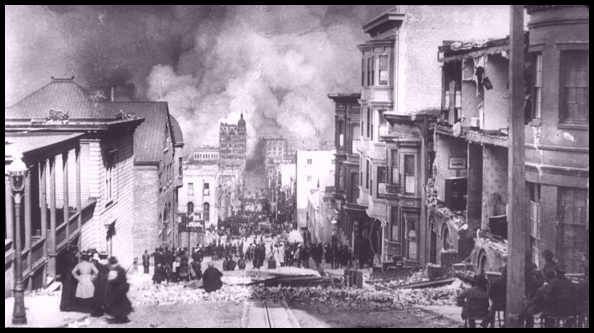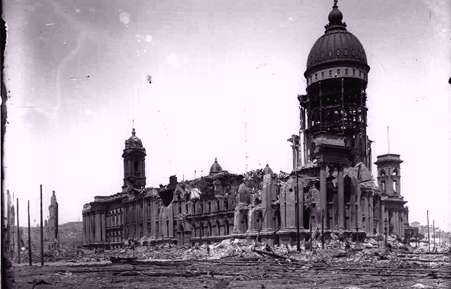A powerful earthquake that hit Northern California on April 18, 1906, was one of the worst natural disasters in American history, killing about 3,000 people and destroying most of the city of San Francisco.
 The Richter scale was not in use at the time of this quake, but later estimates put the Richter scale-equivalent at a magnitude of 7.8. Decades of minor quakes led up to the huge earthquake, which occurred at 5:12 a.m. along the San Andreas Fault and lasted about a minute. The epicenter is thought to have been near Daly City, just south of San Francisco proper. Shaking of varying varieties was reported as far south as Los Angeles and well eastward into Nevada.
The Richter scale was not in use at the time of this quake, but later estimates put the Richter scale-equivalent at a magnitude of 7.8. Decades of minor quakes led up to the huge earthquake, which occurred at 5:12 a.m. along the San Andreas Fault and lasted about a minute. The epicenter is thought to have been near Daly City, just south of San Francisco proper. Shaking of varying varieties was reported as far south as Los Angeles and well eastward into Nevada.
The shaking uprooted trees and buildings, displaced railroad tracks, downed power lines, broke gas lines and water mains, and created huge amounts of rubble all over the city. In all, about 80 percent of the buildings fell.
The huge amount of initial shaking resulted in nearly 400 deaths straight away. A much more deadly consequence of the earthquake, however, was a series of fires that devastated the city and resulted in the majority of the fatalities. Of the city’s pre-quake population of 400,000, more than half that were left homeless.
Estimates of deaths as a result of the earthquake and the subsequent fires range up to 3,000. Among the most prominent fatalities was Dennis Sullivan, the city’s fire chief, who suffered grave injuries in the initial quake and died soon after that.
Fires numbered in the several dozen. One particularly well known fire was set accidentally, by a woman who, after the quake, was trying to make breakfast for her family. That fire spread quickly and became known as the “Ham and Eggs Fire.” (As a result, survivors were given instructions to do their cooking outside, in controlled areas.)
 Other fires resulted from firefighters using dynamite in an attempt to create firebreaks out of demolished buildings. Not least because the quake had shattered the city’s water mains, most fires burned for up to four days before finally being extinguished or just burning themselves out.
Other fires resulted from firefighters using dynamite in an attempt to create firebreaks out of demolished buildings. Not least because the quake had shattered the city’s water mains, most fires burned for up to four days before finally being extinguished or just burning themselves out.
North of San Francisco, in Santa Rosa, damage was severe, with much of the downtown turned to rubble. Also hard hit was San Jose, a bit south of San Francisco.
Further South along the San Andreas Fault, in Monterey County, the quake changed the course of the Salinas River, diverting the mouth of the river six miles south.
The disaster resulted in extraordinarily large insurance claims (some estimates were of $250 million) and also a large amount of relief money from all across the country and world.
In the wake of the disaster, forces of the U.S. Army built thousands of temporary houses, in which displaced people lived well into the following year. At their peak, these “temporary camps” housed more than 16,000 people. The U.S. Government sent large amounts of emergency aid.
The San Francisco earthquake of 1906 is one of the most well-known quakes, not only for its death toll and widespread devastation to the city’s buildings, but also because of the intense amount of study that has been done in the years since then. Geologists have repeatedly performed intense analysis on the San Andreas Fault and its surroundings faults, poring over the data recovered after the earthquake and applying the later innovation of plate tectonics to help understand subsequent quakes elsewhere in California and in the rest of the country.